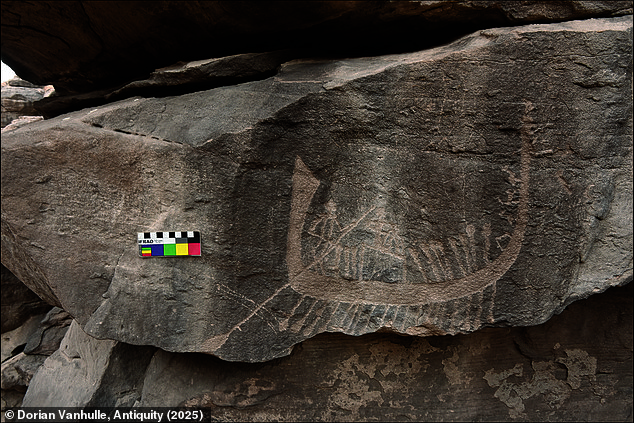[ad_1]
Archaeologists have uncovered a rare Egyptian rock carving that could reveal the secrets of the ancient kings.
Found carved into a stone near the southern Egyptian city of Aswan, researchers believe the etching may date back to the fourth millennium BC – centuries before the first pyramids.
The remarkably well-preserved carvings show a figure seated on an ornate boat, pulled by five other individuals while another steers with an oar.
This seated figure bears the features of the earliest Egyptian kings, such as the long, pointed fake beards worn by the pharaohs.
According to a new study, published in the journal Antiquities, this seated figure is a member of the ancient Egyptian political and military elite from the First Dynasty period.
This time was a critical moment for the ancient Egyptians as it saw the beginnings of political unification across Egypt.
This ultimately culminated in the formation of the Egyptian state under the first pharaoh, Narmer, in 3100 BC.
However, the researchers are certain the figure is not Pharaoh Narmer, meaning the true identity of this warrior elite remains a mystery.

Archaeologists have found a rare ancient Egyptian rock carving which could reveal the secrets of Egypt’s first kings

The carvings were found near the Southern Egyptian city of Aswan, close to the east bank of the Nile
The fascinating carving was found in a large outcropping of sandstone in an area which has been used as a quarry since at least 330 BC until the present day.
Multiple carvings from different periods have been found around the quarry, but this latest discovery is the first to date back as far as the First Dynasty.
The picture was found covered with rubble along a narrow recess accessible by a sandy ledge.
When it was created, anyone standing by the carving would have a great view down to the Nile below.
The boat in the carving is depicted facing North, which would be upstream if it were travelling up the Nile.
The researchers suggest that this may explain the presence of the five figures pulling the boat along with ropes.
The fact that this carving depicts a boat is significant because they are among the most frequently recurring motifs in ancient Egyptian art.
Study author Dr Dorian Vanhulle, an Egyptologist at the Musée du Malgré-Tout in Belgium, says: ‘The boat is ubiquitous and invested with complex ideological and symbolic meanings.’

The carving depicts an ornate boat being pulled by five figures. Onboard, one figure steers with a long oar while another sits, partially hidden by a palanquin (an early form of human-powered transport consisting of a box carried by people)
Dr Vanhulle was able to determine the age of the image by comparing it to other depictions of boats from various periods.
This analysis suggests that the figure was carved during the period that Egypt was transitioning into the Early Dynastic period, following the unification of Upper and Lower Egypt.
This period saw the birth of ancient Egyptian culture as we would recognise it today, with the emergence of the first political structures and the development of writing.
However, how this transition came about and what society looked like for the people involved remains something of a mystery.
In depictions from the period, groups of figures capped with feathers are gradually replaced by images showing a single figure wearing a crown.
Archaeologists know that early forms of power in the country were centred around local or regional authorities, which were often in conflict.
Evidence suggests that the transition was unlikely to have been peaceful and was likely driven by violence.
Dr Vanhulle says: ‘State formation in Ancient Egypt and the processes that led to it are still difficult to conceptualise.’

The carvings were located on a sandstone outcrop overlooking the River Nile. Archaeologists believe they date back to the fourth millennium BC

Archaeologists believe that the carvings were commissioned by a member of Egypt’s early political elite during the transition into the Early Dynastic Period, before the reign of first Pharaoh Narmer in 3100 BC
This carving gives a valuable insight into how the country’s political elite spread their influence and proclaimed their power.
Importantly, the carving bears a strong resemblance to the official imagery produced towards the beginning of Pharaoh Narmer’s reign.
This, combined with the carving’s excellent quality, suggests that it was commissioned by someone important.
Dr Vanhulle says: ‘The rock panel is an important addition to the existing corpus of engravings that can help us to better understand the role of rock art in the crucial events that led to the formation of the Egyptian state.
‘Rock compositions became a tool for the authorities to communicate, mark the landscape and assert their power.’
[ad_2]
This article was originally published by a www.dailymail.co.uk . Read the Original article here. .

